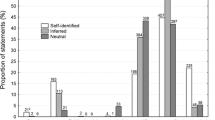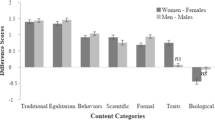Abstract
More than 30 million titles of “academic” articles, from the years 1945–2001, were surveyed for occurrences of the wordssex andgender. At the beginning of this period, uses ofgender were much rarer than uses ofsex, and often used in the sense of a grammatical category. By the end of this period, uses ofgender outnumbered uses ofsex in the social sciences, arts, and humanities. Within the natural sciences, there was now more than 1 use ofgender for every 2 uses ofsex. The beginnings of this change in usage can be traced to Money's introduction of the concept of “gender role” in 1955 (J. Money, 1955). However, the major expansion in the use of gender followed its adoption by feminists to distinguish the social and cultural aspects of differences between men and women (gender) from biological differences (sex). Since then, the use of gender has tended to expand to encompass the biological, and a sex/gender distinction is now only fitfully observed.
Similar content being viewed by others
References
Baker, S. W. (1980). Biological influences on human sex and gender.Signs: Journal of Women in Culture and Society, 6, 80-96.
Bernard, J. (1971).Women and the public interest. Chicago: Aldine.
Chafetz, J. S. (1974).Masculine/feminine or human? An overview of the sociology of sex roles. Itasca, IL: F. E. Peacock.
Chafetz, J. S. (1978).Masculine/feminine or human? An overview of the sociology of the gender roles (2nd ed.). Itasca, IL: F. E. Peacock.
Cottrell, L. S. (1942). The adjustment of the individual to his age and sex roles.American Sociological Review, 7, 617-620.
Davidoff, L. (1979). Class and gender in Victorian England: The diaries of Arthur J. Munby and Hannah Culwick.Feminist Studies, 3(1), 87-141.
Duberman, L. (1975).Gender and sex in society. New York: Praeger.
Eliot, G. (1860).The mill on the floss. Edinburgh: Blackwood.
Fishman, J. R., Wick, J. G., & Koenig, B. A. (1999). The use of "sex" and "gender" to define and characterize meaningful differences between men and women. InAgenda for research on women's health for the 21st century. (A report of the Task Force on the NIH Women's Health Research Agenda for the 21st century), (Vol. 2, pp. 15-19). Rockville, MD: Office of Research on Women's Health.
Fletcher, D. E. (1991). The eternal battle of sex vs gender.JAMA, 266, 2833.
Gershman, H. (1967). The evolution of gender identity.Bulletin of the New York Academy of Medicine, 43, 1000-1018.
Goodhart, C. B. (1992). Sex and gender.Nature, 359, 182.
Gould, M., & Kern-Daniels, R. (1977). Toward a sociological theory of gender and sex.American Sociologist, 12, 182-189.
Greenson, R. R. (1964). On homosexuality and gender identity.International Journal of Psychoanalysis, 45, 217-219.
Hahn, E. F., Norton, B. I., & Fishman, J. (1977). Influence of gender and castration on liver and CNS N-demethylation of morphine in rats.Life Sciences, 20, 95-99.
Haig, D. (2000). Of sex and gender.Nature Genetics, 25, 373.
Harlap, S. (1979). Gender of infants conceived on different days of the menstrual cycle.New England Journal of Medicine, 300, 1445-1448.
Holter, H. (1970).Sex roles and social structure. Oslo, Norway: Universitetsforlaget.
Kessler, D. A. (1993). Guideline for the study and evaluation of gender differences in the clinical evaluation of drugs.Federal Register, 58(139), 39406-39416.
Kessler, S. J., & McKenna, W. (1978).Gender: An ethnomethodological approach. New York: Wiley.
Kim, J. S., & Nafziger, A. N. (2000). Is it sex or is it gender?Clinical Pharmacology & Therapeutics, 68, 1-3.
Lewine, R. R. J. (1994). Sex: An imperfect marker of gender.Schizophrenia Bulletin, 20, 777-779.
McKenna, W., & Kessler, S. J. (2000). Retrospective response.Feminism and Psychology, 10, 66-72.
Mead, M. (1949).Male and female: A study of the sexes in a changing world. New York: William Morrow.
Millett, K. (1970).Sexual politics. New York: Doubleday.
Money, J. (1955). Hermaphroditism, gender and precocity in hyperadrenocorticism: Psychologic findings.Bulletin of the Johns Hopkins Hospital, 96, 253-264.
Money, J. (1973). Gender role, gender identity, core gender identity: Usage and definition of terms.Journal of the American Academy of Psychoanalysis, 1, 397-402.
Money, J. (1985). Gender history, theory and usage of the term in sexology and its relationship to nature nurture.Journal of Sex and Marital Therapy, 11, 71-79.
Money, J. (1986).Venuses/penuses. Buffalo, NY: Prometheus.
Money, J. (1995).Gendermaps. New York: Continuum.
Money, J. (1996). Preface. In J. Money & A. A. Ehrhardt,Man and woman, boy and girl. Gender identity from conception to maturity. Northvale, NJ: Jason Aronson. (Original work published 1972)
Money, J., & Ehrhardt, A. A. (1972).Man and woman, boy and girl. The differentiation and dimorphism of gender identity from conception to maturity. Baltimore: Johns Hopkins University Press.
Money, J., Hampson, J. G., & Hampson, J. L. (1955a). Hermaphroditism: Recommendations concerning assignment of sex, change of sex, and psychologic management.Bulletin of the Johns Hopkins Hospital, 97, 284-300.
Money, J., Hampson, J. G., & Hampson, J. L. (1955b). An examination of some basic sexual concepts: The evidence of human hermaphroditism.Bulletin of the Johns Hopkins Hospital, 97, 301-319.
Money, J., Hampson, J. G., & Hampson, J. L. (1957). Imprinting and the establishment of gender role.Archives of Neurology and Psychiatry, 77, 333-336.
Nicholson, L. (1994). Interpreting gender.Signs: Journal of Women in Culture and Society, 20, 79-105.
Oakley, A. (1972).Sex, gender, and society. New York: Harper Colophon.
Ortner, S. B. (1972). Is female to male as nature is to culture?Feminist Studies, 1 (2), 5-31.
Ortner, S. B., & Whitehead, H. (Eds.). (1981).Sexual meanings: The cultural construction of gender and sexuality. Cambridge, UK: Cambridge University Press.
Ounsted, C., & Taylor, D. C. (Eds.). (1972).Gender differences: Their ontogeny and significance. Edinburgh: Churchill Livingstone.
Ovesey, L., & Person, E. (1973). Gender identity and sexual psychopathology in men: A psychodynamic analysis of homosexuality, transsexualism, and tranvestitism.Journal of the American Academy of Psychoanalysis, 1, 53-72.
Parsons, T. (1940). An analytical approach to the theory of social stratification.American Journal of Sociology, 45, 841-862.
Parsons, T. (1942). Age and sex in the social structure of the United States.American Sociological Review, 7, 604-616.
Parsons, T. (1949).Essays in sociological theory pure and applied. Glencoe, IL: Free Press.
Pearson, G. A. (1996). Of sex and gender.Science, 274, 328-329.
Raymond, J. G. (1979).The transsexual empire: The making of the she-male. Boston: Beacon.
Rosaldo, M. Z., & Lamphere, L., (Eds.). (1974).Women, culture, and society. Stanford, CA: Stanford University Press.
Rothman, K. J., & Liess, J. (1976). Gender of offspring after oral contraceptive use.New England Journal of Medicine, 295, 859-861.
Rubin, G. (1975). The traffic in women: Notes on the "political economy" of sex. In R. R. Reiter (Ed.),Toward an anthropology of women (pp. 157-210). New York: Monthly Review Press.
Smyth, D. H. (1968). Gender and sex.British Medical Journal, 2, 368.
Stimpson, C. R., Burstyn, J. N., Stanton, D. C., & Whisler, S. M. (1975). Editorial.Signs: Journal of Women in Culture and Society, 1, v-viii.
Stoller, R. J. (1964a). Gender-role change in intersexed patients.JAMA, 188, 684-685.
Stoller, R. J. (1964b). A contribution to the study of gender identity.International Journal of Psychoanalysis, 45, 220-226.
Stoller, R. J. (1965). Passing and the continuum of gender identity. In J. Marmor (Ed.),Sexual inversion (pp. 190-210). New York: Basic Books.
Stoller, R. J. (1968).Sex and gender: The development of masculinity and femininity. London: Hogarth.
Tobach, E. (1971). Some evolutionary aspects of human gender.American Journal of Orthopsychiatry, 41, 710-715.
Unger, R. K. (1979). Toward a redefinition of sex and gender.American Psychologist, 34, 1085-1094.
Unger, R. K., & Crawford, M. (1993). Sex and gender—The troubled relationship between terms and concepts.Psychological Science, 4, 122-124.
Vance, C. S. (1980). Gender systems, ideology, and sex research: An anthropological analysis.Feminist Studies, 6, 129-143.
Vincent, A. C. J. (1994). Seahorses exhibit conventional sex roles in mating competition, despite male pregnancy.Behaviour, 128, 135-151.
Walker, P. L., & Cook, D. C. (1998). Gender and sex: Vive la difference.American Journal of Physical Anthropology, 106, 255-259.
Wilson, D. R. (2000). Gender vs sex.JAMA, 284, 2997-2998.
Yudkin, M. (1978). Transsexualism and women: A critical perspective.Feminist Studies, 4(3), 97-106.
Author information
Authors and Affiliations
Rights and permissions
About this article
Cite this article
Haig, D. The Inexorable Rise of Gender and the Decline of Sex: Social Change in Academic Titles, 1945–2001. Arch Sex Behav 33, 87–96 (2004). https://doi.org/10.1023/B:ASEB.0000014323.56281.0d
Issue Date:
DOI: https://doi.org/10.1023/B:ASEB.0000014323.56281.0d




